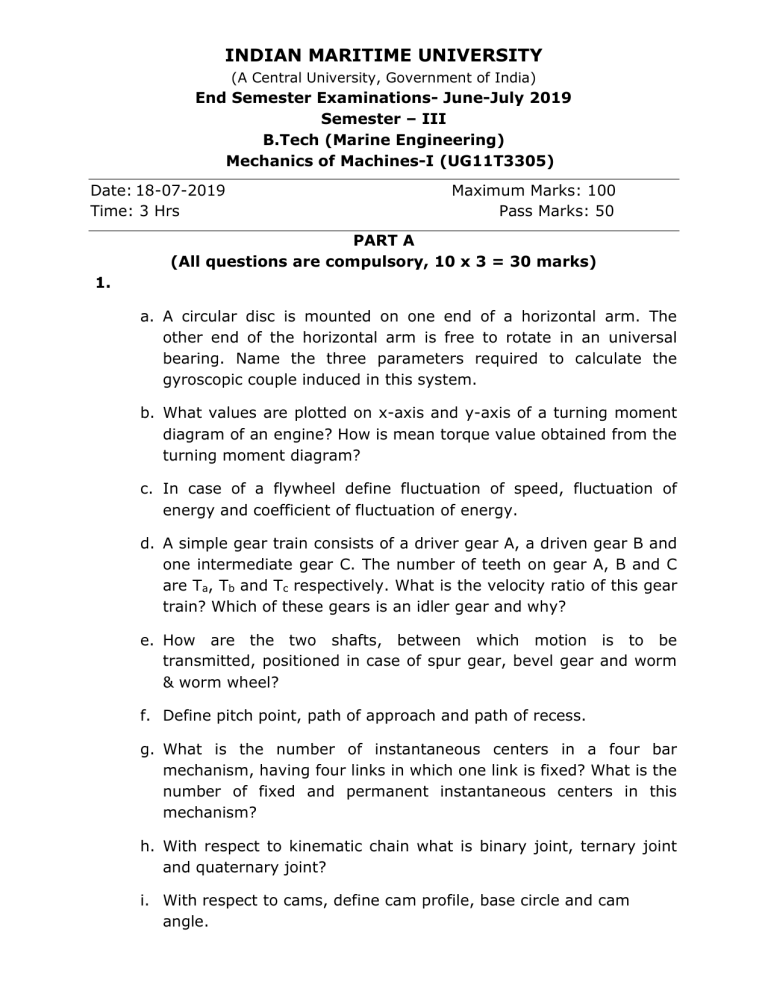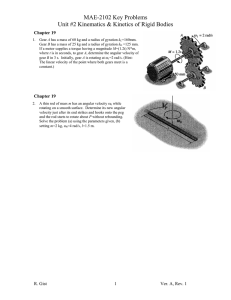
INDIAN MARITIME UNIVERSITY (A Central University, Government of India) End Semester Examinations- June-July 2019 Semester – III B.Tech (Marine Engineering) Mechanics of Machines-I (UG11T3305) Date: 18-07-2019 Time: 3 Hrs Maximum Marks: 100 Pass Marks: 50 PART A (All questions are compulsory, 10 x 3 = 30 marks) 1. a. A circular disc is mounted on one end of a horizontal arm. The other end of the horizontal arm is free to rotate in an universal bearing. Name the three parameters required to calculate the gyroscopic couple induced in this system. b. What values are plotted on x-axis and y-axis of a turning moment diagram of an engine? How is mean torque value obtained from the turning moment diagram? c. In case of a flywheel define fluctuation of speed, fluctuation of energy and coefficient of fluctuation of energy. d. A simple gear train consists of a driver gear A, a driven gear B and one intermediate gear C. The number of teeth on gear A, B and C are Ta, Tb and Tc respectively. What is the velocity ratio of this gear train? Which of these gears is an idler gear and why? e. How are the two shafts, between which motion is to be transmitted, positioned in case of spur gear, bevel gear and worm & worm wheel? f. Define pitch point, path of approach and path of recess. g. What is the number of instantaneous centers in a four bar mechanism, having four links in which one link is fixed? What is the number of fixed and permanent instantaneous centers in this mechanism? h. With respect to kinematic chain what is binary joint, ternary joint and quaternary joint? i. With respect to cams, define cam profile, base circle and cam angle. j. In a symmetrical tangent cam or cam with straight flank, at what positions during out stroke does minimum velocity and maximum velocity occur? PART B (Answer any 5 questions)(14 x 5 = 70 marks) 2. The length of crank and connecting rod of a horizontal reciprocating engine are 0.2 m and 1 m respectively. The crank is rotating at 400 r. p. m. When the crank has turned 30 degrees from the inner dead center, the difference of pressure between the cover end and piston end is 0.4 N/mm2. If the mass of the reciprocating part is 100 kg and cylinder bore is 0.4 m, calculate (a) piston effort (b) angle made by connecting rod with line of stroke (c) thrust on the sides of the cylinder (d) thrust in the connecting rod (e) crank effort (f) turning moment on the crank shaft. (14 marks) 3. A uniform disc of 200 mm diameter has a mass of 10 kg. It is mounted centrally on a horizontal shaft which runs in bearings which are 150 mm apart. The disc spins with a uniform speed of 2000 r. p. m. in vertical plane in counter clockwise direction looking from right hand side bearing. The shaft precesses with a uniform velocity of 50 r.p.m. in horizontal plane in anticlockwise direction looking from top. Determine (a) magnitude of gyroscopic couple (b) the direction and plane of reactive gyroscopic couple and (c) total reaction at each bearing due to mass and gyroscopic effect. (14 marks) 4. The turning moment diagram for a multi-cylinder engine is drawn to the scale of 1 cm = 5000 Nm and 1 cm = 60 degrees. The intercepted areas between the output torque curve and mean resistance line taken in order are - 0.3, + 4.1, - 2.8, + 3.2, - 3.3, + 2.5, - 3.6, + 2.8, - 2.6 cm2 when the engine is running at 800 r. p. m. The engine has a stroke of 30 cm and the fluctuation of speed is not to exceed 2 percent of the mean speed. The material density is 7.2 g/cm 3. Thickness of the rim is one fourth of the width. The limiting value of the shaft centrifugal stress is 280 x 105 N/m2. Determine: (a) a suitable diameter of the flywheel rim (b) maximum fluctuation of energy (c) moment of inertia of flywheel (d) mass of the flywheel (e) width and thickness of the flywheel rim. (14 marks) 5. A pinion with 20 teeth is in mesh with a gear of 60 teeth. The pressure angle is 20 degrees. Addendum for both pinion and gear is 7 mm. Module is 7 mm. The pitch line velocity is 1.4 m/s. Find: (a) length of path of approach (b) length of path of recess (c) length of path of contact (d) length of arc of contact (e) angular velocity of both pinion and gear (f) sliding velocity at start of engagement (g) sliding velocity at disengagement (14 marks) 6. In a reverted epicyclic gear train arm F, carries two wheels A and D and a compound wheel B-C. All four gears have equal module. Wheel A meshes externally with wheel B. Wheel D meshes externally with wheel C. Number of teeth on gear A is 40. Number of teeth on gear D is 24. Number of teeth on gear C is 36. Wheel A is fixed. Arm F rotates at 300 rpm clockwise. Find (a) number of teeth on gear B (b) develop table to determine speed of all gears (c) speed of gear D using tabular method (d) direction of rotation of gear D (14 marks) 7. The angle between two meshing spiral gears is 90 degrees and center distance is 150 mm approximately. The normal circular pitch of the gear is 10 mm and the gear ratio is 2.5. The frictional angle is 6 degrees and the efficiency of the drive is maximum. Determine (a) the spiral angles of the teeth (b) circular pitch of each gear (c) number of teeth on each gear (d) pitch circle diameter of each gear and (f) the efficiency of the drive. (14 marks) 8. Draw the profile of a cam operating a knife edge follower. The axis of the follower passes through the axis of the cam. Follower performs out stroke of 40 mm during 180 degrees of cam rotation. Follower returns to its original position during the next 180 degrees of cam rotation. The displacement of the follower is to take place with uniform velocity during both the out stroke and return stroke. The least radius of the cam is 50 mm. (14 marks) **********




